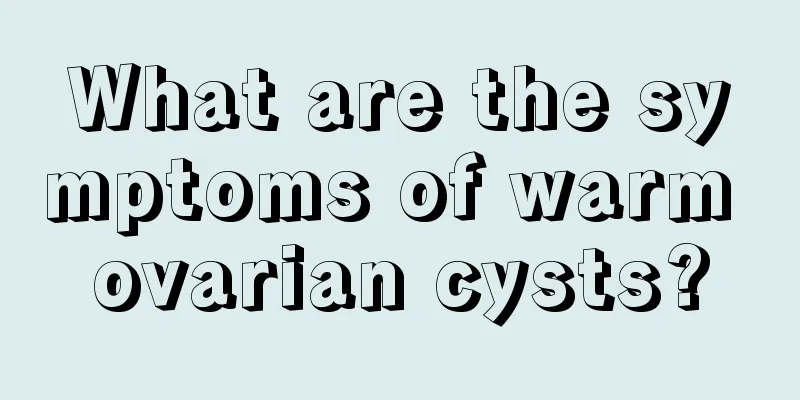What are the symptoms of warm ovarian cysts?

|
Ovarian cyst is a common gynecological disease. There are many symptoms when ovarian cyst occurs, such as delayed menstruation, abnormal leucorrhea, and often lead to infertility in women. Sometimes it also causes abdominal pain and urinary system symptoms. There are many classifications of ovarian cysts. If it is a physiological cyst, the harm is relatively small. Be alert to cysts caused by pathological reasons. What are the symptoms of warm ovarian cysts? 1. Dysmenorrhea begins or becomes worse. 2. My period used to come on schedule, but recently it has become irregular. 3. Long-term infertility. Studies have found that ovarian cysts are a cause of infertility, which has no direct relationship with the size of the cyst. 4. When you stand up after exercise or sitting still, you will feel some pain in your lower abdomen. This is because the accumulated fluid in the cyst causes the ovaries to sag under the action of gravity, causing a feeling of heaviness and pain during exercise. 5. Actively trying to lose weight but not seeing any results. Some people find that their bloating becomes more and more severe during the weight loss process, but this is not caused by obesity or pregnancy, but rather by ovarian cysts. Some women often fail to notice the distension of their abdomen because of their plump figure. 6. Frequent urination or difficulty urinating, which is caused by the larger cyst squeezing the bladder. Classification of ovarian cysts 1. Physiological cyst In most cases, physiological cysts are not a disease, do not require surgery, and will disappear on their own. This type of cyst actually comes about like this: Women of childbearing age ovulate every month. Before ovulation, the ovary develops to a certain size, and due to changes in hormone levels, it ruptures and the egg comes out. The structure of the ovary also conforms to the morphological characteristics of a "cyst", with a theca membrane on the outside and follicular fluid inside. When it grows large, it can reach 3 to 4 cm in size. This is called a "follicular cyst". After ovulation, the follicle collapses to form a corpus luteum. The shape of the corpus luteum also meets the characteristics of a "cyst", with a layer of membrane on the outside and corpus luteum tissue inside (similar to the structure of a steamed bun). The corpus luteum of menstruation can also grow up to 3cm in size. 2. Inflammatory cysts Sometimes women who have had pelvic inflammatory disease will develop adhesions in their pelvis. These membranous adhesions surround each other and form a sphere, which contains inflammatory fluid. B-ultrasound will also tell you that this is a "cyst". Clinically, we call this an "inflammatory mass". For this type of "cyst", active anti-inflammatory treatment is usually considered first. Surgical exploration is only considered when anti-inflammatory treatment is ineffective. However, patients need to understand that inflammatory masses may recur after treatment, whether with medication or surgery, but they have never heard of them becoming cancerous. 3. Tumor cyst This type of cyst is the most classic explanation of cysts treated clinically. It is caused by ovarian cell disease, which has the same pathogenesis as tumors. Due to the complex tissue composition of the ovaries, there are many types of such cysts, most of which are benign, while a few are malignant, that is, cancer. 4. Hemorrhagic cyst It is usually secondary to follicular cyst or corpus luteum cyst, which is clinically known as follicular rupture or corpus luteum rupture. Since blood clots may form inside, the mass may appear as "mixed" on B-ultrasound. 5. Chocolate Cyst A relatively special and common type of cyst. It can cause dysmenorrhea and is one of the main causes of female infertility. Its cause is that endometrial cells appear on the ovaries, causing bleeding every month during menstruation, and the bleeding accumulates in the sac to form a cyst. With repeated bleeding, the cyst will become larger and larger, and the blood inside will become old and mixed with some secretions of the endometrial glandular epithelium to form a viscous chocolate-colored liquid. Therefore, it is called "chocolate cyst", but its real name should be "endometriosis cyst". |
<<: What are the symptoms of false pregnancy?
>>: What are the symptoms of menopause in women
Recommend
Symptoms of vaginal cancer
Vaginal cancer is a malignant tumor among gynecol...
In late pregnancy, the amount of amniotic fluid increases
During pregnancy, female friends must have regula...
What medicine should I take for menopausal Yin deficiency and hyperactivity of fire?
When many women reach menopause, they will always...
Sometimes thick, sometimes thin, the "face-changing game" of the endometrium, how much do you know?
Author: Chen Yongning, attending physician of the...
Why does my baby always hiccup when I am eight months pregnant?
From the first month of pregnancy to the middle a...
I still have blood after a week of abortion.
Painless abortion is a very popular abortion meth...
Brown jelly discharge during ovulation
The secretions during ovulation can reflect our c...
How much does areola reduction surgery cost?
In the current cosmetic medical market, the price...
Why do the leaves of the water-grown lucky bamboo turn yellow? What should I do if the leaves of the water-grown lucky bamboo turn yellow?
Lucky bamboo is very common in our daily life. Ma...
What is the amniotic fluid index at 29 weeks?
Many women are always worried about their own neg...
What to do if breast milk fat content is low
The low fat content of breast milk can be improve...
What to do if you are one week pregnant
After many women learn that they are pregnant, th...
How much do you know about the causes of transient vertigo?
Dizziness is an extremely common phenomenon in li...
Causes and treatment of breast pain during breastfeeding
For some mothers who are breastfeeding, sometimes...
How to judge skin allergies? What are the common allergy symptoms?
Anyone who has had an allergy knows how uncomfort...









